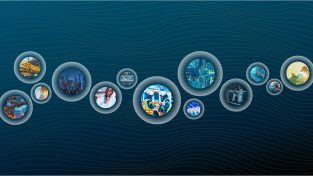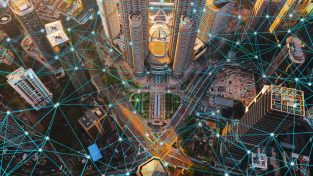The scale and complexity of disasters are continuing to increase, and agencies are fighting to keep pace. Strategies and tactics that worked yesterday may no longer be effective tomorrow. How can leaders make effective adaptations in this uncertain environment? In this HxGN Radio episode, Dr. Satyamoorthy Kabilan, Vice President for the Public Policy Forum, will detail the key requirements needed for public safety leaders to succeed in emergency management.
ZN: In today’s unpredictable and often hectic climate, emergency management has been forced to evolve in response to changes in the size and scope of modern disasters. We welcome in Dr. Satyamoorthy Kabilan, vice president of the Public Policy Forum to HxGN radio. I want to say first and foremost, thank you for joining us. And as we continue, may I call you Kabi?
SK: Please do.
ZN: Beautiful. All right. Kabi, I was hoping we could start today by describing the environment emergency management leaders currently find themselves in. What are the kinds of things that we’re facing day to day on the ground?
SK: Well, that’s a really interesting question to start with because I think I can safely say the only constant that emergency management professionals face today is change.
ZN: Okay.
SK: You don’t know from day to day whether you’re going to wake up and have to deal with, is there going to be a wildfire today? Is it going to be a flood, a hurricane, a tornado, an active shooter? Is there going to be someone with a vehicle going downtown? The unfortunate truth is there are emergency managers who’ve had to deal with most of those, if not almost all of them. So, we live in a fairly unpredictable environment. It’s changing constantly. And I think the real challenge in all of that is, is what you learned as an emergency manager and what, you’ve been using for the last 10-20 years, is that still going to get you success in a world where things have changed so significantly from the time when you first trained and when you first learned?
ZN: Yes, and I think that’s a perfect point. And I guess the question then, I’m assuming our listeners are going to be asking, and that I want to know is, overall, as this has extended over time, what has the response been on behalf of these managers?
SK: I think that emergency managers across the globe have suddenly woken up to the fact that things are changing really quickly, and it’s pretty unpredictable in terms of the environment that they have to deal with. Suddenly, the all hazards approach, you don’t think about your emergency just in terms of, say, a wildfire if you live in a high wildfire risk area. You do think about the other threats that you might have to face. So, one of the things that I think has suddenly embedded itself within the emergency management profession is recognizing that it’s not just going to be a weather disaster. You might face a whole range of things, and how do you prepare for that?
I think the second big piece that has really registered with emergency managers today is, they are coming to the realization that those old techniques, the old tools, the things that we learnt before, the things that have been the pillars of emergency management for maybe the last two, three, four decades may not necessarily be the best tools to get you through in the future. So, I think a lot of them are waking up to the fact that hey, we have to do things a little bit differently if we want to succeed.
ZN: Sure. In terms of those pressure points, are they facing the most uncertainty in terms of the events themselves? Is it just in the aspect that these things are constantly changing? Where is this coming up the most?
SK: Well, literally, it’s in almost everything. So, in the events… Well, think about it this way. If you think about the city of Toronto, not too long ago, they had an individual in a van drive through pedestrians. But the person who was in the van was not radicalized in the ideologies that most people would normally assume he has, adhering to a misogynistic ideology. And that was what drove him to take his actions by the reports that we’ve seen. So, even in the incidents that do occur… So, first of all, it’s who would expect the van to go through a downtown city and hit people. You know, three or four years ago, probably no one. Today, almost everyone. So, the incident itself has changed.
The second thing that’s changing is, even within those incidents, who’s doing it? Why is this happening? That’s changed. That applies to natural disasters as well, if you think about flooding, if you think about where it’s gone. Hurricane Sandy, I think, was an incredible wake-up call for the city of New York, just in terms of the challenge it could provide. So, we’re seeing not only the incidents changing, but within those incidents itself, the aspects of how you deal with it, what we might be responsible for, what sort of issues it causes. All of that’s changing, which is why I go back to the original point I made. The only thing constant in today’s emergency management environment is change and evolution.
ZN: Sure. I’m assuming then that you would say that the stakes are higher now than they’ve ever been?
SK: Absolutely. Think about it this way. What’s the first place you go to for information in an emergency, or where do you first hear from it? I think 9 out of 10 people, if not more, would probably answer on social media somewhere.
ZN: Twitter probably for me, yeah.
SK: Exactly. And more and more, we’re getting… Not only are we getting information very quickly, we’re getting it from multiple sources. There’s so much attention focused on each and every incident. I think the old saying that’s been used a number of times when it comes to communications and the modern social media world is, if you don’t feed the beast, the beast will feed itself. And the beast is large, and the beast is everywhere, so there is a huge amount of attention. There is a huge amount of interest. Everybody wants to know everything, and they want to know it right now. So, yes, in today’s world, I think that’s another big challenge. Whereas previously, if you were managing an incident, you might be able to go, “You know, I’ll wait. I’ll wait until I know more before I say anything.” In today’s world, you might have had thousands of people commenting on the incident with false information, with things they are speculating about because they haven’t heard from you.
ZN: Yeah, I like the concept of a ubiquitous beast to that.
SK: It is, it is indeed. Actually, it’s really interesting to say ubiquitous beast. I always think about social media this way. If you only get onto social media when an emergency occurs, you might as well not have you used it. Because social media, ubiquitous is the right word, it’s not something that just pops up every now and then. It’s something you need to build. You need to cultivate, you need to build trust, you need to have an audience. And if you don’t do that in advance, the beast is ubiquitous. It doesn’t wait to pop up when you want it. So, you have to be on there. It’s a commitment. It’s a constant need to be part of that conversation. And I think that’s something that sometimes emergency managers don’t quite realize. They think their role is just in the emergency.
ZN: Yep. So, let’s pick that up then because I think what you’re talking about is some of the characteristics that you want to see from these emergency management leaders. The first question is, what are the best attributes that these leaders can have? And the second question is, how have these characteristics needed to evolve over time in order to adapt to the change that we’re seeing day to day?
SK: Well, first and foremost, I will say that any characteristics I give you today will be relevant based on what we’ve seen recently.
ZN: Sure.
SK: But with that constant mantra of change, it might have evolved by the time we speak again in the future. So, that’s one thing to keep in mind. If we start looking at those emergency management officials who’ve been really successful, when you’ve seen good responses, and we look across them, there are some key characteristics that emerge. One of those characteristics, which I think people really need to keep in mind today, is the need for innovation. Now, innovation equals risk. By definition, if something’s innovative, it’s risky.
ZN: 100%.
SK: Can you imagine an emergency manager saying, “Okay, we don’t quite know. Let’s try that new thing, or a new tool, or a new approach in the midst of emergency?”
ZN: Yep.
SK: That’s probably just about as far removed as from how most emergency management professionals would like to operate. But it’s a necessity today because if the tools that we used previously and the techniques, the processes that we use, start failing as we go forward, can we simply rely on the same old tools as we did before? We’ve seen this in emergencies time and time again. If you, for example, only rely on traditional communications and traditional tools for emergency communication between the public and first responders, will you remain relevant?
It’s a great example from the hurricanes we had in the southern US. The normal approach most emergency management professionals use is, “Okay, in an emergency, don’t tweet us, don’t send us a Facebook message. Call 911.” What happens when 911’s overwhelmed? What happens when a volunteer group, in this case, the Cajun Navy shows up and says, “You know what? Call us on Facebook. Send us a message. We’ll come help.” And they did. In fact, they did a great job, a great example of volunteers who made a difference. So, now we’re seeing a complete shift in paradigm. You can’t just rely on what you used to do before. You have to start going to where people want to communicate.
ZN: I can’t remember what book it is. I was reading this recently, actually, but it was essentially saying that, especially in very high leveraged, high-pressure, high-risk situations, we tend to fall back on previous repeated patterns of behavior because that’s what neurologically we lock back into. And this is sort of a side point, but I’m curious. How then, for those emergency management leaders, as we’re getting into situations that are increasingly more predictable, you mentioned the southern hurricanes, increasingly more unpredictable in terms of ecological events… Are there things that they can do within their agencies in order to make those responders more ready to kind of shrug off maybe the natural training and say, “Okay, this is a different kind of thing. This change is now coming to me. How am I going to respond in the moment?”
SK: Yes. So, when we started off this conversation, you were talking about innovation and risk, and I think that’s the key here. You need to have a frontline, and right up to the top line in emergency management that’s comfortable with taking risks and trying new things. But you have to do it in a structured way. You can’t exactly take a risk with someone’s life directly. So, you know, you do have to draw certain lines as to where you do things. And it isn’t about breaking your old training. It is about understanding what the outcome of that training is. So, if you had a standard communications protocol that says, “I’ll stand in front of the TV for 20 minutes, or I’ll do a radio interview and that will be it,” what’s the outcome you’re aiming for? You’re aiming for better public knowledge.
ZN: Right.
SK: So, that’s the outcome. You can still get to that outcome, but now you’d use some new tools. So, that’s how we should look at innovation and how we should look at risk-taking. Where is it that we’re trying to reach an outcome where the current tools are being challenged? They can’t quite get us to that outcome. And so, what can we do to try something new that will help us reach there?
Leaders today need to be supportive of those who are willing to take some of those risks in a controlled way, but very importantly, willing to learn from them. Not all of these risks are going to work out. So, what do you learn? What do you implement? And kind of on the side of that, it’s don’t just look in the same old places. If you want new ideas, you need to look outside. Great examples from Hurricane Sandy, using designers and others to look at different ways to create reception centers on the back of disasters. We had virtual volunteers show up at Hurricane Sandy. One side of which developed a whole fuel availability map.
ZN: Oh, wow.
SK: Absolutely innovative. The skills to do that were not present in government, but they did it. So, you also need to look outside the traditional emergency management boundaries for new ideas.
ZN: Okay. I think those are some key points of emphasis. And I’m assuming that when you’re talking to these leaders, those are some of the things you’re highlighting.
SK: Absolutely.
ZN: Let me ask one, because those are a lot of, really, what we would call soft skills, right? So, I want to move to the hard skills real quick. In terms of our ability to take in data, to then analyze that data, and then apply it to emergency response, can you give our listeners a little bit of some insight as to where you think maybe we’re being inefficient in that process right now, what you think we’re doing really well, but kind of an overview of how data plays a role in emergency response?
SK: When my team studied the response to Hurricane Sandy, we met with Joe Bruno, who is the former commissioner for emergency management in the City of New York. He had a great phrase which he used that day, which is, “If you lose the data, you lose the emergency.” And that was a recognition that data provides us with so much: the ability to really understand our situation, the ability to give us very specific awareness and to help make our actions really impactful and more efficient. And that data’s all around us today. We’re gathering it in so many ways.
Data today is absolutely core in terms of what emergency management leaders need to understand in terms of what’s available, what they can glean from it, and how they then get those insights into action right at the frontline. So, there was certainly a challenge within. Let’s start with the emergency response family. There is a challenge for us informers in terms of recognizing the data, where is it, how you can get access to it, how you can use it, how you can build insights out of it, and we have to always be careful because when it comes to data and analytics, garbage in equals garbage out.
ZN: Do you think that process is getting easier?
SK: I think it certainly is because there’s a broader recognition about the importance of data. I’ve certainly seen in some of the best examples of emergency management where the organizations have broken down the silos across the different divisions that they work in. The city of Calgary is a great example for this. If you go to their emergency operations center, you’ll see the seats for different city functions in there, all the way from police, to different branches of the city, and then, some of the core organizations that are important to any form of response. And here’s where the second nugget comes in around data. Even as an emergency response organization or even as government, you’re probably not going to have all the data you need. A lot of it’s going to be outside with the private sector.
ZN: Last question mentioned garbage in, garbage out. Are we getting better data right now?
SK: Yes and no.
ZN: Okay.
SK: But data is actually there in most cases. In most cases, there’s some very good data. But finding it, making sure you can access it, and then building good analytics on top of it? Not always the greatest thing. I think the challenge has been, and as I said, that’s starting to happen, is, first of all, breaking down the silos so you know what data you’ve got to start with, and you know what you’ve got to play with. Because when you get the very limited set, it’s not so much whether it’s garbage in, garbage out, but it’s also a very limited view of the world.
So, yes, we’re getting better at it. We’re getting better at recognizing good data. Don’t just use data because it’s there. You use data because it can actually lead you to insight, and that, I think is in the garbage in, garbage out argument. Because if you’re simply using data because it’s data, that’s not going to give you anything. If you’re using data because it’s relevant and can give you an insight which will help you in your response, you are more than likely to get good value out.
ZN: I want to give a big thank you, a huge thank you to our guest, to Kabi, for coming here today and talking to us. For more information about emergency response and what we talked about today, please visit www.hexagonsafetyinfrastructure.com. If you want to listen to additional episodes or learn more, please visit hxgnspotlight.com. Thank you all so much for tuning in.
















